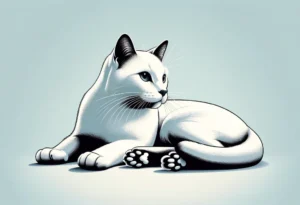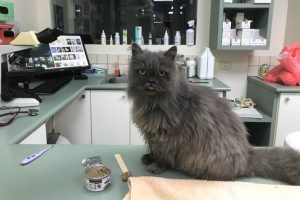Are you wondering why some cats have crooked tails? Let’s uncover the fascinating reasons behind this unique trait.
Have you ever noticed a cat with a tail that isn’t quite as straight as it should be? The crookedness of a cat’s tail can be attributed to a variety of factors, from genetics to injuries.
The Role of Genetics
Have you ever noticed that some cats have crooked tails while others have perfectly straight ones? This difference can be attributed to the role of genetics in determining the shape of a cat’s tail. Just like humans inherit certain traits from their parents, cats can also inherit genetic markers that influence the development of their tails.
Genes play a significant role in shaping a cat’s tail, with certain genetic variations leading to the formation of a crooked tail. These genetic factors can affect the way a cat’s tail grows and develops, resulting in a unique appearance that sets them apart from other felines.
While it’s not entirely uncommon for cats to have crooked tails due to genetic inheritance, it’s essential to remember that each cat is an individual with their unique characteristics. This genetic influence can result in a variety of tail shapes and sizes, making each cat truly one-of-a-kind.
If you’ve ever wondered why your cat’s tail is crooked, consider the genetic makeup that they have inherited from their parents. This genetic predisposition plays a crucial role in determining the overall appearance of your feline friend’s tail.
Developmental Abnormalities
Apart from genetics, developmental abnormalities during a cat’s growth can also lead to the formation of a crooked tail. These abnormalities can occur during the embryonic stage or later in the cat’s life, impacting the way their tail develops over time.
One common cause of a crooked tail due to developmental abnormalities is an injury or trauma that affects the growth of the tail. In some cases, a cat may experience a fracture or damage to their tail, leading to a misalignment or curvature in its structure.
Additionally, certain health conditions or environmental factors can contribute to developmental abnormalities in a cat’s tail. For example, nutritional deficiencies or exposure to toxins can hinder normal growth and development, resulting in a crooked tail.
If you notice that your cat’s tail is crooked, it’s essential to consult with a veterinarian to determine the underlying cause. By identifying any developmental abnormalities early on, you can ensure that your cat receives the necessary care and treatment to maintain their health and well-being.
Tail Trauma
Did you know that injuries or traumas can result in a cat having a crooked tail? Just like humans, cats can experience accidents or injuries that affect the shape and structure of their tails. If a cat’s tail is bent or broken due to trauma, it may heal in a crooked or misaligned position, leading to a permanent change in its appearance. So, if you notice a cat with a crooked tail, it might be a result of a past injury that has altered the natural shape of their tail.
Additionally, it’s crucial to handle cats with care to prevent any potential tail injuries. Avoid pulling or tugging on their tails, and create a safe environment for them to explore without the risk of accidents. By being mindful of their surroundings and providing a safe space, you can help reduce the chances of your feline friend ending up with a crooked tail due to trauma.
Tail Positioning
Have you ever considered how the positioning of a cat’s tail can impact its overall shape and structure? Cats use their tails for communication, balance, and expressing emotions. The way a cat positions its tail can influence its development and appearance over time. If a cat consistently carries its tail in a certain position, it may lead to the tail becoming permanently crooked or bent.
Moreover, genetics play a role in determining the natural shape of a cat’s tail. Some breeds of cats are more predisposed to having crooked tails due to genetic factors. Keep in mind that while you can’t change your cat’s genetics, providing a comfortable and stress-free environment can help maintain their tail health and prevent any potential issues.
Tips for Tail Health:
- Encourage regular play and exercise to keep your cat’s tail muscles strong.
- Watch for any changes in tail behavior or appearance, and consult a veterinarian if you notice anything unusual.
- Provide scratching posts and toys to help your cat engage in natural tail movements.
By understanding the impact of tail positioning and taking proactive steps to promote tail health, you can help your feline companion maintain a straight and strong tail throughout their life.
Breeds with Crooked Tails
Curious about why some cats have those adorable crooked tails? Well, it turns out that certain cat breeds are more prone to having these unique tails. Breeds like the American Bobtail, Japanese Bobtail, and Manx are known for their distinctive tails that may be curved or kinked. These traits are often genetic, passed down from ancestors who also had this quirky feature. So, if you have one of these breeds in your furry family, you might notice their tail taking on a charming twist!
Here’s a fun fact: Cats with crooked tails are not only cute but can actually be a conversation starter. Embrace your cat’s unique features and share their tail tale with friends and family!
Tail Health and Care
Caring for a cat with a crooked tail is important to ensure their overall well-being. Regular grooming is key to keeping their tail clean and free from tangles. Brushing your cat’s tail gently can help prevent mats and knots, especially if their tail is curved. Regular check-ups with the vet are also essential to monitor your cat’s tail health and address any issues early on.
When it comes to playtime, choose toys that won’t put strain on your cat’s tail. Opt for toys that encourage gentle movement and avoid games that may stress or bend their tail in uncomfortable positions. Remember, a happy cat with a crooked tail is a healthy cat!
Additional Tip:
- Observe your cat’s tail regularly for any changes in appearance or behavior. If you notice anything unusual, such as swelling or sensitivity, consult your vet promptly for further evaluation. Your vigilance can help catch any potential issues early on, ensuring your furry friend stays happy and healthy.
Common Myths Debunked
Let’s put an end to the rumors: cats with crooked tails are not the result of accidents or injuries. Contrary to popular belief, a cat’s tail doesn’t become crooked from getting stuck in a door or encountering a mishap. The truth is, some cats are simply born with a unique tail structure that gives them their special charm. So, rest assured, those crooked tails are a natural part of these feline friends’ individuality.
Uniqueness and Individuality
Embrace the quirks of cats with crooked tails! These feline companions showcase their individuality in a fascinating way, adding to their overall charm. Each cat with a crooked tail has a story to tell, a trait that sets them apart from the rest. This unique feature only enhances their beauty and makes them stand out in the most adorable way.
Did you know? In Japan, cats with crooked tails are believed to bring good luck and fortune to their owners. This cultural belief demonstrates the appreciation for these special cats and their intriguing tail variations.
To further appreciate these lovable felines, take a moment to observe how their crooked tails add a touch of character to their already distinctive personalities. Next time you encounter a cat with a crooked tail, celebrate their uniqueness and the joy they bring into your life.
Alex, a passionate animal lover, has experience in training and understanding animal behavior. As a proud pet parent to two dogs and three cats, he founded AnimalReport.net to share insights from animal experts and expand his knowledge of the animal kingdom.









